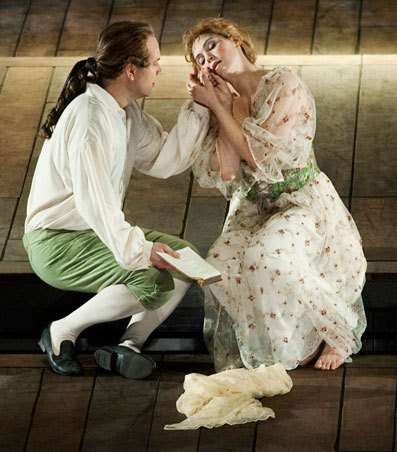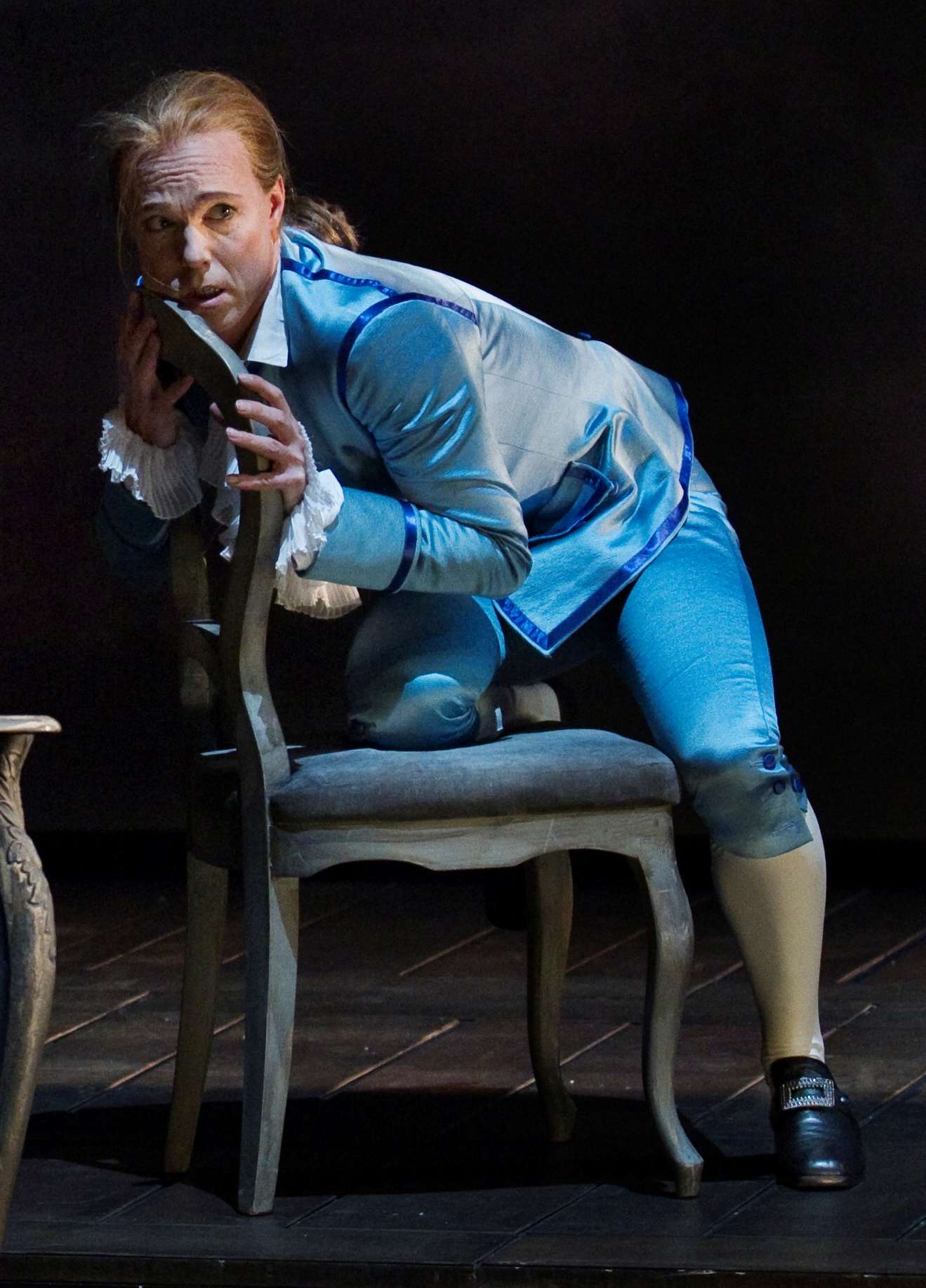|
Back
A New Danish Classic: Copenhagen
The Royal Danish Opera House, Main Stage
11/16/2011 - & November 22, 24*, 29, December 2, 6, 9, 13, 2011
Bo Holten: Livlægens Besøg
Johan Reuter (Johann Friedrich Struensee), Gert Henning-Jensen (Christian VII), Sten Byriel (Ove Høegh-Guldberg), Elisabeth Jansson (Caroline Mathilde), Anne Margrethe Dahl (Dowager Queen Juliane Marie), Djina Mai-Mai (Booted-Cathrine), Lars Waage (Carl Schack Rantzau), Bengt-Ola Morgny (Enevold Brandt), Mogens Gert Hansen (Frederik V), Poul Høxbo (Tamborinaire), Jens Bruno Hansen (An executioner), Per Lundsgaard (Reverdil), Hans Lawaetz (A bishop), Torben Demstrup (First priest), Stefan Cushion (Second priest), Johan Hallsten (Third priest), Simon Schelling (Bernstorff), Ulla Kudsk Jensen (Fru von Plessen), Ole Jegindø Norup (Courtier), Magnus Gislason (The president of the council), Trunte Aaboe (A lady-in-waiting), Stefan Cushion (A judge), Clara la Cour Bødtcher-Jensen (Princesse Louise Augusta), Tori Cooper, Elena Lucas, Adeline Crosa, Marie-Claire Newton, Nadia Dahl, Allan Clausen, Robert Thomsen, Paulo Marcilio, Shaun Kelly, Robin Bernadet, and Jennifer Wagstaff (Puchinella dancers)
The Royal Danish Opera Orchestra and Chorus, Philip White (chorus master), Bo Holten (conductor)
Peter Oskarson (director), Peter Holm (set and costume designer), Per Sundin (lighting designer), Jan Mark (production dramaturge), Kajsa Giertz (movement director)

J. Reuter, E. Jansson (© Miklos Szabo/Courtesy of Royal Danish Opera)
About 20 km north of Copenhagen, my Danish friend made a short detour so we could view the site of the summer castle that was the venue of the most notorious of all Danish love affairs, that of the teen-aged Queen Caroline Mathilde and the German physician Johann Friedrich Struensee, who had been brought to Denmark to treat the confused mind of King Christian VII. Had Struensee just tended the king and comforted the queen, he would be forgotten now, but he was a true believer in the Enlightenment and used his access to the king to reform government policy and structure. This riled the nobility and dowager queen, who forced the mad king to condemn Struensee, his friend and father figure, to a cruel death. After the hand amputation, decapitation, and quartering of Struensee and culture minister Brandt and the exiling of the queen in 1772, the summer castle was abandoned and demolished after 40 years. Today, after 240 years, the natural charm of the place persists. Without a single green tree on stage, the second act of The Visit of the Royal Physician brings the lovers to life in the ease of their country retreat, as the king lives alongside them in his disintegrating state of mind, and the plotting ensnares them.
In this revival of Bo Holten’s opera, The Visit of the Royal Physician (premiere 2009), the human and political drama unrolls before our eyes and ears in a multi-art package that is a major contribution to Danish opera. It will also be well received internationally, when the time comes, though singing in Danish may be a challenge. To ensure that soloists and chorus can enunciate naturally and be understood, Holten paid close attention to the score in relation to the libretto (written by Per Olov Enquist and Eva Sommestad Holten). He accomplished his purpose: The Danish-speaking public simply listened and enjoyed, rarely having to refer to overtexts, which for this production are in English rather than Danish.
To concentrate the drama and emotion of the individual scenes – about 10 in each act – is also Holten’s focus. He therefore uses many different styles of music, old and new, always with a modern twist and true to the dramatic characters and situations. It was a privilege to experience this new classic with the composer at the helm of the Royal Danish Opera Orchestra, which played stupendously. Given Holten’s life-long involvement with choruses in Denmark and abroad, it is also not surprising that the Royal Danish Opera Chorus has a major role in The Visit of the Royal Physician.
His genial composition is backed up by Peter Oskarson (director) and his team, who created a scenic concept around four main motifs. First, the crack in the sliding stage walls that symbolize the moment a character decides something important, for example, Struensee as he realizes he will use his power for the greater good. Second, the theatre of death, which we see in the vicious court, the court theatre where the lovers dance before being seized in their beds, and the gruesome execution scene that stuns the animated crowd to silence. Third, the world of nature in which the lovers thrive, despite the confusion and dangers around them, and fourth, the puchinella, the long-nosed, black-masked, cone-hatted commedia dell’arte dancers in white that are present from start to finish and effectively used for a number of purposes. Among them, the Pantomime Theatre dancers act out the fantasies in the king’s mind; propel the queen towards marriage and maturity; and represent the prostitutes in the old king’s bed, the free spirit of summer (butterfly clowns), and the soldiers that pursue and destroy.
The main roles must be perfectly cast in this dramatic work for it to work. Two of the leads had just finished roles in Così fan tutte: Johan Reuter (Struensee) sang lyrically and dramatically, portraying a man of ideals and action: serious, earnest, in his most effective age, and Elisabeth Jansson (Carolina Mathilda) impressed again with her acting skills and rich mezzo.

G. Henning-Jensen (© Miklos Szabo/Courtesy of Royal Danish Opera)
Gert Henning-Jensen (Christian VII) was perfect in the role of confused prince/king, projecting mental anguish and distraction with voice, face and body, and Sten Byriel (Ove Høegh-Guldberg) used his authoritative bass and presence to criticize the physician and devise and carry out the execution order. Anne Margrethe Dahl (dowager queen Juliane Marie) was a haughty co-conspirator, and Djina Mai-Mai (Booted-Catrina, Christian VII’s mistress), Lars Waage (Carl Schack Rantzau, Struensee’s friend, later on conspirator against him), Bengt-Ola Morgny (Enevold Brandt, killed before Struensee) were all aptly chosen for their roles, as were many other colorful characters.
When the applause stopped, a woman in her 20s in the row in front of me remarked, in Danish: "That was the best opera I have ever seen!" The Visit of the Royal Physician, a modern historical drama focused on real events, easy to understand, and with different kinds of music, action, singing, and dancing, is indeed a gift to us all.
Kathleen Gail Jensen
|